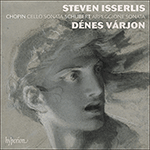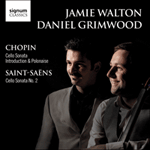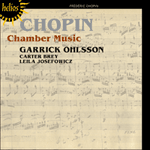While there is no composition by Chopin that does not involve the piano, the cello is the only other instrument for which he wrote any significant music. His first effort was a polonaise written in 1829 when he was visiting the home of Prince Radziwill, governor of the Principality of Poznan and himself a composer and cellist of sorts. Writing to his friend Tytus Woyciechowski in November, he is rather dismissive of his ‘alla polacca’ describing it as ‘nothing more than a brilliant drawing-room piece suitable for the ladies’. He hoped that the Prince’s daughter, Wanda, would practise the piano part (he was supposed to be giving her lessons) in which case she must have been an accomplished pianist, though her father would not have found the cello part over-taxing. The following year Chopin added an introduction, inspired by his friendship in Vienna with the cellist Joseph Merk. The Introduction and Polonaise brillante in C major for piano and cello Op 3 was dedicated to Merk. Carl Czerny (1791–1857) produced a piano solo version of the work but in the 1980s an arrangement by Chopin himself was unearthed.
from notes by Jeremy Nicholas © 2010
En dehors de l’omniprésent piano, le violoncelle fut le seul instrument pour lequel Chopin conçut quelque musique d’importance. Sa première tentative fut une polonaise qu’il rédigea en 1829, lors d’un séjour chez le prince Radziwill, gouverneur du grand-duché de Posnanie, lui-même un peu compositeur et violoncelliste. Dans une lettre à son ami Tytus, en novembre, Chopin ne fit pas grand cas de son «alla polacca», n’y voyant «rien de plus qu’un brillant morceau de salon pour les dames». Il espéra que la fille du prince, Wanda, en travaillerait la partie de piano (il était censé lui donner des leçons de piano), auquel cas ce devait être une pianiste accomplie—son père, lui, ne dut pas être surmené par la partie de violoncelle. L’année suivante, Chopin ajouta une introduction inspirée par son amitié viennoise avec celui qui en sera le dédicataire de l’Introduction et Polonaise brillante en ut majeur pour piano et violoncelle op. 3, le violoncelliste Joseph Merk. Carl Czerny (1791–1857) produisit une version pour piano solo de cette œuvre, dont on exhuma aussi un arrangement de Chopin dans les années 1980.
extrait des notes rédigées par Jeremy Nicholas © 2010
Français: Hypérion
Während es keine Komposition gibt, bei der das Klavier nicht beteiligt ist, ist das Cello das einzige andere Instrument, für das Chopin irgendeine bedeutendere Musik geschrieben hat. Sein erster Versuch war eine Polonaise aus dem Jahre 1829, anlässlich eines Besuches bei Fürst Radziwill, dem Statthalter der Provinz Posen, der selbst komponierte und ein ordentlicher Cellist war. In einem Brief an seinen Freund Tytus im November äußert er sich ziemlich abschätzig über sein „alla polacca“ und beschreibt es als „nichts mehr als ein brillantes Salonstück für feine Damen“. Er hoffte, dass Wanda, die Tochter des Fürsten, den Klavierpart übernehmen würde (vermutlich gab er ihr Klavierstunden), wobei sie dann eine sehr versierte Pianistin hätte sein müssen; ihr Vater allerdings dürfte den Cello-Part nicht als Überforderung angesehen haben. Im folgenden Jahr fügte er eine Einleitung hinzu, die durch die Freundschaft mit dem Cellisten Joseph Merk angeregt worden war und die er als Introduction et Polonaise brillante in C-Dur für Klavier und Cello op. 3 Merk widmete. Carl Czerny (1791–1857) schuf eine Klavierversion des Werkes; 1980 wurde allerdings eine Bearbeitung von Chopin selbst ausgegraben.
aus dem Begleittext von Jeremy Nicholas © 2010
Deutsch: Ludwig Madlener


 Chopin: Cello Sonata; Schubert: Arpeggione Sonata
Chopin: Cello Sonata; Schubert: Arpeggione Sonata Chopin & Saint-Saëns: Cello Sonatas
Chopin & Saint-Saëns: Cello Sonatas Chopin: Chamber Music
Chopin: Chamber Music
